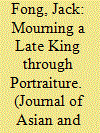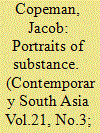| Srl | Item |
| 1 |
ID:
164384


|
|
|
|
|
| Summary/Abstract |
This article employs an urban sociological reading to examine mourning portraiture in the primate city of Bangkok, Thailand, following the death of King Bhumibol Adulyadej (Rama IX). The article argues that Bangkok’s mourning portraiture constructs a reified notion of the Thai nation acceptable to Bangkok’s elites. Through a narrative that sacralizes the late king’s historical exploits for the Thai people, Bangkok’s elites have harnessed the affluent shopping district of Pathum Wan as an aesthetic and political canvas for showcasing the transcendent and virtuous nature of their late monarch. With mourning portraiture as figure and Bangkok’s Pathum Wan as background, the nationalist implications of the imagery as they render sacred the late monarch are considered. The article concludes that the capital city’s sacralization of a deceased king is but an attempt by pro-royalist banking families to reinforce their class linkages to the Thai aristocracy by ‘working towards the monarchy,’ a trajectory illuminated by Serhat Ünaldi, one which I hope to make visible in the post-death context of mourning Rama IX.
|
|
|
|
|
|
|
|
|
|
|
|
|
|
|
|
| 2 |
ID:
124956


|
|
|
|
|
| Publication |
2013.
|
| Summary/Abstract |
This essay examines the way extractions of human blood - for medical donations, portrait paintings, and petitions - have come to form a significant means of political communication (particularly as a means of political protest) throughout India, focusing in particular on a case study from the south of a karate teacher and artist who, through painting multiple portraits of the Tamil Nadu Chief Minister with his blood, sought land for his karate school. The second half of the essay explores wider features of India's 'sanguinary politics', focusing in particular on ways in which publicly witnessed deployments of political activists' own blood once seemed to promise both intensification and purification of mass political idioms. It also considers how and why this promise has largely remained unfulfilled.
|
|
|
|
|
|
|
|
|
|
|
|
|
|
|
|